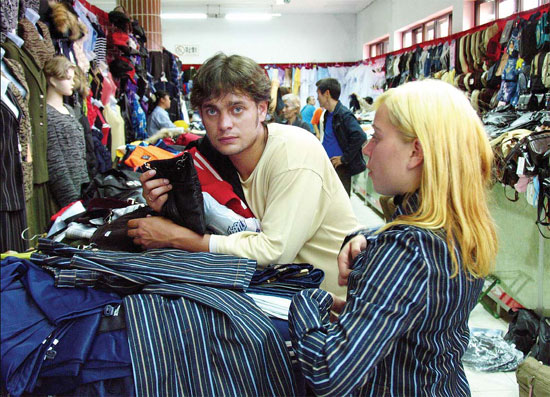China builds on border trade
Updated: 2013-03-04 07:50
By Li Jiabao in Beijing and Wang Kaihao in Manzhouli, Inner Monglia (China Daily)
|
||||||||
|
Two Russian businesspeople in a garment market in Manzhouli in North China's Inner Mongolia autonomous region. Border trade has brought prominence to Manzhouli as China's largest inland port, accounting for about 70 percent of land trade between China and Russia. Amid deepening China-Russia ties, the city, with a population of 300,000 in 2012 and a size of 732 square kilometers, is experiencing a new boom. Liu Zhaoming / For China Daily |
Russia's entry to WTO creates huge opportunities for entrepreneurship
Russia's accession to the World Trade Organization and the consequent tariff reduction with China implies promising opportunities for Chinese businesses as border trade between the two countries is expected to boom.
"We have finished production for all the orders before May," said Ge Shengchun, general manager of Jasmine Glass Technology Co based in Manzhouli, a city in Northeast China's Inner Mongolia autonomous region that borders Russia to the north and Mongolia to the west.
Ge set up the 20,000-square- kilometer glass plant in 2008 with an investment of 250 million yuan ($40.05 million). About 90 percent of his products, including concave glass, frosted glass and armoured glass, were sold to Russia and cornered more than half of the markets in cities in the Russian Far East, including Chita, Ulan-Ude and Irkutsk.
"Our priority is not the Chinese market. We are diversifying out overseas markets to reduce risks. We will enter the Hungary market this year and may set up sales networks in South Asian countries such as India in the future," he said.
Another regional businessman, Yu Hongwei, deputy manager of Manzhouli Yiliya Fruits Trade Co, said: "Price is our biggest competitive edge. Our product quality is in the middle level."
The company exports about 40,000 tons of vegetables and fruits to Russia every year, about 10 percent of Manzhouli's total fresh food exports. Tomatoes account for the biggest share. A total of 320,000 tons of vegetables and fruits passed through the Manzhouli customs' Shibali port in 2012. A specially dedicated lane reduced the one-time hour-long passage to less than 20 minutes, according to the port's deputy director Liu Juan.
Border trade has brought prominence to Manzhouli as China's largest inland port, accounting for about 70 percent of land trade between China and Russia. Amid deepening China-Russia ties, the city, with a population of 300,000 in 2012 and a size of 732 sq km, is facing a new boom. China's determination to open up inland regions and Russia's accession to the WTO is set to improve trade and investment environments.
The two nations' bilateral trade saw an increase of 7.1 percent year-on-year to reach $7.68 billion in January, while China's exports rose 26 percent compared with the same month in 2012, according to the Ministry of Commerce.

 Li Na on Time cover, makes influential 100 list
Li Na on Time cover, makes influential 100 list
 FBI releases photos of 2 Boston bombings suspects
FBI releases photos of 2 Boston bombings suspects
 World's wackiest hairstyles
World's wackiest hairstyles
 Sandstorms strike Northwest China
Sandstorms strike Northwest China
 Never-seen photos of Madonna on display
Never-seen photos of Madonna on display
 H7N9 outbreak linked to waterfowl migration
H7N9 outbreak linked to waterfowl migration
 Dozens feared dead in Texas plant blast
Dozens feared dead in Texas plant blast
 Venezuelan court rules out manual votes counting
Venezuelan court rules out manual votes counting
Most Viewed
Editor's Picks

|

|

|

|

|

|
Today's Top News
Boston bombing suspect reported cornered on boat
7.0-magnitude quake hits Sichuan
Cross-talk artist helps to spread the word
'Green' awareness levels drop in Beijing
Palace Museum spruces up
First couple on Time's list of most influential
H7N9 flu transmission studied
Trading channels 'need to broaden'
US Weekly

|

|








